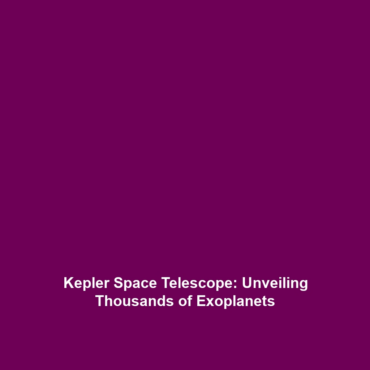The Impact of Science Fiction on Exoplanet Research: How Sci-Fi Has Inspired Real-Life Exoplanet Exploration
The realm of exoplanets—planets beyond our solar system—continues to spark curiosity and ignite the imagination. Intriguingly, the narratives crafted in science fiction have profoundly influenced real-life research and exploration of these distant worlds. By exploring the intersection of sci-fi and exoplanet study, we can uncover how imaginative literature and film have galvanized both scientific inquiry and public interest in the quest for habitable planets and extraterrestrial life.
Key Concepts
Understanding the impact of science fiction on exoplanet research requires examining several core concepts:
- Imagination as a Catalyst: Many exoplanet researchers cite sci-fi as a motivating force, inspiring theoretical frameworks and innovative technologies.
- Visualizing the Unknown: Sci-fi often presents visions of alien worlds that challenge our understanding and push the boundaries of what’s possible in science.
- Public Engagement: Science fiction generates public enthusiasm about space exploration, which in turn influences funding and support for scientific research.
Applications and Real-World Uses
The integration of science fiction concepts into exoplanet research has led to notable applications:
- Technological Innovation: Ideas from sci-fi stories have shaped the development of advanced telescopes and space probes designed for exoplanet discovery.
- Planetary Habitat Concepts: Sci-fi narratives about terraforming and colonization of alien worlds inform current studies about maintaining human life on exoplanets.
- Search for Extraterrestrial Intelligence (SETI): Fictional portrayals of alien communication have inspired real initiatives aimed at detecting signals from intelligent life on distant planets.
Current Challenges
Despite the wealth of inspiration provided by science fiction, several challenges remain in the study of exoplanets:
- Scientific Limitations: Current technology imposes constraints on our ability to identify and analyze exoplanets accurately.
- Funding Issues: Public interest can be fleeting; sustaining funding for long-term exoplanet research projects can be difficult.
- Interpretation of Data: Distinguishing between potentially habitable exoplanets and non-habitable ones based on current methods poses a significant challenge.
Future Research and Innovations
The future of exoplanet research, inspired by the imaginative realms of science fiction, is bright. Anticipated breakthroughs include:
- Next-Generation Space Telescopes: Upcoming missions, such as the James Webb Space Telescope, promise to revolutionize our ability to gather data on exoplanet atmospheres.
- Artificial Intelligence: Utilizing AI to process vast amounts of data may lead to quicker identification of exoplanet candidates.
- Biomarkers Detection: Innovations in identifying chemical signals indicative of life on exoplanets are being actively pursued.
Conclusion
The interplay between science fiction and exoplanet research highlights an essential narrative—one where creativity meets scientific inquiry. As we continue to push the boundaries of our understanding of exoplanets, the influence of imaginative storytelling remains significant. The contributions of sci-fi to exoplanet exploration underscore the importance of interdisciplinary approaches in addressing complex scientific questions.
For further insights into the fascinating world of exoplanets and ongoing research, explore our related articles on Exoplanet Discovery and The Search for Extraterrestrial Intelligence.









